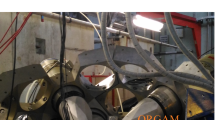Conclusions
Our calculation of the trajectories of the fission fragments in the experiment of [4] showed that the density effect becomes much weaker when the nonlinear relation between the ion charge and the velocity of the fragments during the stopping process is taken into account. The calculation was based on measurements of the energy losses of fission fragments in air, which were performed in the present work, and modern data on energy losses in argon. The error of the experiment described in the present work is close to 10%. It can be asserted to the same degree of accuracy that the density effect does not influence the energy losses in the experimental pressure range from 300 to 8000 Pa.
This work was supported by the Russian Fund for Fundamental Research, project No. 96-02-17443a.
Similar content being viewed by others
References
H. Betz, “Charge states and charge-changing cross section of fast heavy ions penetrating through gaseous and solid media,” Rev. Mod. Phys.,44, No. 3, 465–539 (1972).
N. Lassen. “Total charges of fission fragments as a function of the pressure of the stopping gas.” Math.-Fyz. Medd. Kgl. Danske Vid. Selskab,26, No. 12, (1951).
N. Lassen, “The total charges of fission fragments in gaseous and solid stopping media,” ibid.Math.-Fyz. Medd. Kgl. Danske Vid. Selskab,26, No. 5(1951).
C. Fulmer and B. Cohen, “Equilibrium charges of fission fragments in gases,” Phys. Rev.,109, No. 1, 94–99 (1957).
A. P. Budnik, O. N. Katsuro, and Yu. V. Sokolov, “Description of the stopping power of inert gases for fission fragments in the classical theory of binary collisions,” Preprint No. FÉI-2495, Physics and Power Engineering Institute (1996).
R. Govil et al., “Measurement of specific energy losses of individual fission fragments with back to back ΔE-E detector system,” Nucl. Instrum. Meth. B,4, No. 1, 13–19 (1984).
D. Biswas, M. Rao, and R. Choudhury, “Specific energy-loss behavior of fission fragments along their range in P-10 gas,” ibid.Nucl. Instrum. Meth. B,53, No. 3, 251–254 (1991).
L. D. Landau and E. M. Lifshitz, Quantum Mechanics [in Russian], Nauka, Moscow (1974).
J. Lindhard and M. Scharff, “Notes on atomic collisions” Phys. Rev.,124, 128 (1961).
J. Lindhard, M. Scharff, and H. Schiott, “Range concepts and heavy ion range,” Math.-Fys. Medd. Kgl. Danske Vid. Selskab,33, No. 14 (1963).
J. Lindhard, V. Nielsen, M. Scharff, and P. Thomsen, “Integral equation governing radiation effects,” ibid.Math.-Fys. Medd. Kgl. Danske Vid. Selskab,33 No. 10(1963).
Y. Laichter, H. Geissel, and N. Shafrir, “On the nuclear charge and atomic mass of attenuated mean fission fragments,” Nucl. Instrum. Meth.,194, Nos. 1–3, 45–50 (1982).
R. Batra and A. Shotter, “Passage of fission fragments through thin film plastic scintillators,” Nucl. Instrum. Meth. B,5, 14–19 (1984).
M. Brown and C. Moak, “Stopping powers of some solids for 30–90 MeV238U ions,” Phys. Rev. B,6, No. 1, 90–94 (1972).
B. Cohen, A. Cohen, and C. Coley, “Energy distribution of mass-97 fission fragments from thermal-neutron fission of uranium-235,” Phys. Rev.,104, No. 4, 1046–1053 (1956).
Additional information
Main Science Center of the Russian Federation—A. I. Leipunskii Physics and Power Engineering Institute. Translated from Atomnaya Énergiya, Vol. 83. No. 1, pp. 7–12, July, 1997.
Rights and permissions
About this article
Cite this article
Rykov, V.A. Energy losses of fission fragments and the density effect in gases with different collision frequencies. At Energy 83, 483–487 (1997). https://doi.org/10.1007/BF02418972
Received:
Issue Date:
DOI: https://doi.org/10.1007/BF02418972




